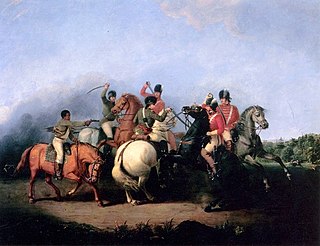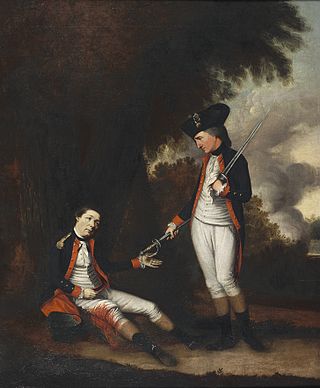
The Battle of Camden, also known as the Battle of Camden Court House, was a major victory for the British in the Southern theater of the American Revolutionary War. On August 16, 1780, British forces under Lieutenant General Charles, Lord Cornwallis routed the numerically superior American forces led by Major General Horatio Gates about four miles north of Camden, South Carolina, thus strengthening the British hold on the Carolinas following the capture of Charleston.

The Battle of Harlem Heights was fought during the New York and New Jersey campaign of the American Revolutionary War. The action took place on September 16, 1776, in what is now the Morningside Heights area and east into the future Harlem neighborhoods of northwestern Manhattan Island in what is now part of New York City.

The siege of Charleston was a major engagement and major British victory in the American Revolutionary War, fought in the environs of Charles Town, the capital of South Carolina, between March 29 and May 12, 1780. The British, following the collapse of their northern strategy in late 1777 and their withdrawal from Philadelphia in 1778, shifted their focus to the North American Southern Colonies. After approximately six weeks of siege, Major General Benjamin Lincoln, commanding the Charleston garrison, surrendered his forces to the British. It was one of the worst American defeats of the war.

The Battle of Kings Mountain was a military engagement between Patriot and Loyalist militias in South Carolina during the Southern Campaign of the American Revolutionary War, resulting in a decisive victory for the Patriots. The battle took place on October 7, 1780, 9 miles (14 km) south of the present-day town of Kings Mountain, North Carolina. In what is now rural Cherokee County, South Carolina, the Patriot militia defeated the Loyalist militia commanded by British Major Patrick Ferguson of the 71st Foot. The battle has been described as "the war's largest all-American fight".

The Battle of Pell's Point, also known as the Battle of Pelham, was a skirmish fought between British and American troops during the New York and New Jersey campaign of the American Revolutionary War. The conflict took place in what is now part of Pelham Bay Park in the Bronx, New York City and the villages of Pelham Manor and Pelham in Westchester County, New York.
South Carolina was outraged over British tax policies in the 1760s that violated what they saw as their constitutional right to "no taxation without representation". Merchants joined the boycott against buying British products. When the London government harshly punished Massachusetts for the Boston Tea Party, South Carolina's leaders joined eleven other colonies in forming the Continental Congress. When the British attacked Lexington and Concord in the spring of 1775 and were beaten back by the Massachusetts Patriots, South Carolina Patriots rallied to support the American Revolution. Loyalists and Patriots of the colony were split by nearly 50/50.

The Carolinas campaign, also known as the campaign of the Carolinas, was the final campaign conducted by the Union Army against the Confederate Army in the Western Theater of the American Civil War. On January 1, Union Maj. Gen. William T. Sherman advanced north from Savannah, Georgia, through the Carolinas, with the intention of linking up with Union forces in Virginia. The campaign culminated in the defeat of Confederate Gen. Joseph E. Johnston's army at the Battle of Bentonville, and its unconditional surrender to Union forces on April 26, 1865. Coming just two weeks after the defeat of Robert E. Lee's army at the Battle of Appomattox Court House, it signaled that the war was effectively over.

The Battle of Fort Washington was fought in New York on November 16, 1776, during the American Revolutionary War between the United States and Great Britain. It was a British victory that gained the surrender of the remnant of the garrison of Fort Washington near the north end of Manhattan. It was one of the worst Patriot defeats of the war.

The 84th Regiment of Foot (Royal Highland Emigrants) was a British regiment in the American Revolutionary War that was raised to defend present-day Ontario, Quebec, and Atlantic Canada from the constant land and sea attacks by American Revolutionaries. The 84th Regiment was also involved in offensive action in the Thirteen Colonies; including North Carolina, South Carolina, Georgia, Virginia, and what is now Maine, as well as raids upon Lake Champlain and the Mohawk Valley. The regiment consisted of 2,000 men in twenty companies. The 84th Regiment was raised from Scottish soldiers who had served in the Seven Years' War and stayed in North America. As a result, the 84th Regiment had one of the oldest and most experienced officer corps of any regiment in North America. The Scottish Highland regiments were a key element of the British Army in the American Revolution.

The southern theater of the American Revolutionary War was the central theater of military operations in the second half of the American Revolutionary War, 1778–1781. It encompassed engagements primarily in Virginia, Georgia, North Carolina, and South Carolina. Tactics consisted of both strategic battles and guerrilla warfare.

The Battle of Stono Ferry was an American Revolutionary War battle, fought on June 20, 1779, near Charleston, South Carolina. The rear guard from a British expedition retreating from an aborted attempt to take Charleston held off an assault by poorly trained militia forces under American General Benjamin Lincoln.

The Battle of Sullivan's Island or the Battle of Fort Sullivan was fought on June 28, 1776, during the American Revolutionary War. It took place near Charleston, South Carolina, during the first British attempt to capture the city from American forces. It is also sometimes referred to as the first siege of Charleston, owing to a more successful British siege in 1780.
The 71st Regiment of Foot was a British Army regiment of infantry raised in 1775, during the American Revolutionary War and unofficially known as Fraser's Highlanders. It was disbanded in 1786.

The Capture of Savannah was a battle of the American Revolutionary War fought on December 29, 1778. It pitted an American garrison of Continental Army and militia units against a British invasion force commanded by Lieutenant-Colonel Archibald Campbell. The capture of the city led to an extended occupation and was the opening move in the British southern strategy to regain control of the rebellious Southern Colonies by appealing to the relatively strong Loyalist sentiment there.
The Battle of the Combahee River took place during the American Revolutionary War on August 27, 1782, near Beaufort, South Carolina, one of many such confrontations after the Siege of Yorktown to occur before the British evacuated Charleston in December 1782. Lieutenant Colonel John Laurens, a 27-year-old Southern abolitionist, previously a diplomat and an aide-de-camp to George Washington, who was lauded as "one of the bravest and most gallant of the American officers," was killed during the confrontation.
The Province of Georgia was a significant battleground in the American Revolution. Its population was at first divided about exactly how to respond to revolutionary activities and heightened tensions in other provinces. Georgia was the only colony not present in the First Continental Congress in 1774. When violence broke out in 1775, radical Patriots took control of the provincial government, and drove many Loyalists out of the province. Georgia subsequently took part to the Second Continental Congress with the other colonies. In 1776 and 1778, Georgia served as the staging ground for several important raids into British-controlled Florida. The British army captured Savannah in 1778, and the American and French forces failed to recapture the city during the Siege of Savannah in 1779. Georgia remained under British control until their evacuation from Savannah in 1782.

The history of Virginia in the American Revolution begins with the role the Colony of Virginia played in early dissent against the British government and culminates with the defeat of General Cornwallis by the allied forces at the Siege of Yorktown in 1781, an event that signaled the effective military end to the conflict. Numerous Virginians played key roles in the Revolution, including George Washington, Patrick Henry, and Thomas Jefferson.
William "Bloody Bill" Cunningham (1756–1787) was an American loyalist infamous for perpetrating a series of bloody massacres in South Carolina's backcountry in the fall of 1781 as commander of a Tory militia regiment in the Revolutionary War. Though his family were loyal to the British crown, Cunningham initially enlisted in the Continental Army as part of the State of South Carolina's 3rd regiment in 1775. His tenure in the rebel army was an unhappy one and Cunningham changed sides to fight for the British in 1778. He earned the nickname "Bloody Bill" for the violent, ruthless nature of his raids on rebels and patriot civilians.

The Battle of Tulifinny was a military engagement of the American Civil War that was fought from December 6–9, 1864 in Jasper County, South Carolina during Sherman's March to the Sea. Outnumbered five-to-one, a Confederate force led by Major-General Samuel Jones, consisting in part of the entire cadet corps of the South Carolina Military Academy, successfully defended a strategically important section of the Charleston and Savannah Railway from attacks by Union forces. The engagement was one of the rare occasions when the United States Marine Corps fought in combat during the conflict.














